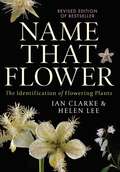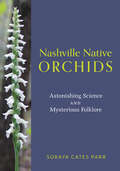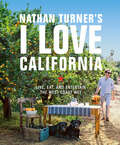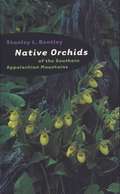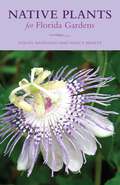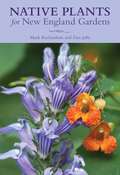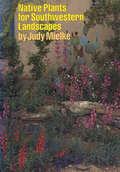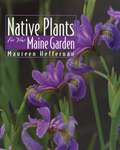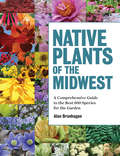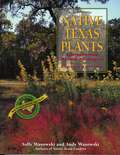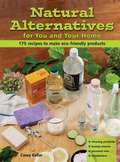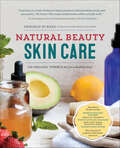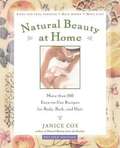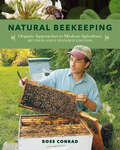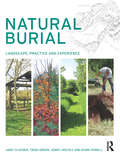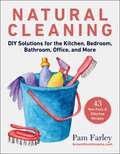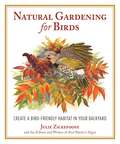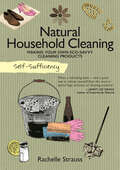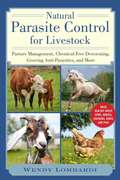- Table View
- List View
Name that Flower: The Identification of Flowering Plants: 3rd Edition
by Helen Lee Ian ClarkeName That Flower is a valued source of clear and concise information on identifying flowering plants from around the world, both cultivated and in the wild. This edition is updated to align with current systems of plant classification that incorporate advances in molecular DNA analysis. It includes more than 130 detailed line drawings, 64 colour pages and information on 46 plant families. The illustrations depict a selection of widely distributed gardens plants and weeds, and species native in eastern and southeastern Australia. Easily navigated, the book facilitates the successful use of standard identification manuals and online resources available in most parts of the world and introduces the reader to the arrangement of flowers on plants, reproduction, plant structure and function, and the way species are grouped and named. Methods for dissecting flowers and observing their structure for identification purposes are clearly described. This bestseller is used extensively as a teaching text in numerous courses concerned with the natural world, such as agriculture, horticulture, botany, environmental management and landscape design, as well as botanical art. It is an essential reference for serious gardeners and keen botanists, professional and amateur.
Nantucket Cottages and Gardens: Charming Spaces on the Faraway Isle
by Leslie LinsleyA definitive, full-color book to help bring the style of Nantucket Island into your home. There is something essentially charming about a simple cottage surrounded by a fence covered with roses. More than 1,200 of these houses can be found on Nantucket Island. Nowhere in this country are there more charming and diverse cottages featuring small pocket gardens and window boxes than on Nantucket. To a large extent, the character of the island is reflective of these little early homes. They were originally built by and for island residents at a time when islanders didn’t require, didn’t desire, or couldn’t afford anything larger. Living small, as typified by cottage living, has become the responsible, chic, innovative, and practical wave of the immediate future. Many homeowners are rethinking their needs in regard to space, opting for more quality and less quantity of space. They know that a house is more than square footage, and a small home is one that can be infused with special details and designed to accommodate the lifestyle of its occupants. Neither size nor volume has anything to do with style and comfort. The homes and gardens featured in Nantucket Cottages and Gardens reflect classic design elements that have been embraced in the past and continue to survive in the present. Throughout this book, the cottages of Nantucket will inspire those who are building new, renovating, or decorating a small home. When the quantity of space is pared down, more money can be spent on the things that give a house character, such as built-ins, weathered wood furniture, unique art pieces, and handmade textiles, to name a few.
Narcotics: Nature's Dangerous Gifts
by Norman TaylorInformation on marijuana, opium, morphine, heroin, coca, cocaine, alcohol, tobacco, ololiuqui, peyotl (mescaline), pituri, fly agaric, caapi, kava, betel, coffee, chocolate and tea.
Nashville Native Orchids: Astonishing Science and Mysterious Folklore
by Soraya Cates ParrHidden in the greenways, parks, and backyards of Nashville are several varieties of stunning native orchids. The vibrant, three-petaled flower has been revered for centuries for its exoticism and inspirational qualities. But these natural treasures, long part of a rich folk tradition, have been largely forgotten by many Nashvillians. This useful guidebook offers a comprehensive look into the secret lives of Davidson County&’s six native orchid species. Alongside vibrant, eye-catching photographs of plant life cycles that provide a straightforward way for readers to quickly identify these varieties, the book offers the fascinating history of these wild wonders as told by author Soraya Cates Parr, a passionate horticulturalist with a knack for explaining the natural world in an accessible way. More than just a useful guide to Nashville&’s flora, Nashville Native Orchids is a reminder of the risk that unbridled urban development can pose to the delicate natural ecosystem. Throughout the book, Parr shows the local effects of climate change on Nashville&’s native orchid population and advocates for a more sustainable approach to development. Beyond the environmental dimensions, this book presents an illuminating discussion of the historical significance of orchids and their central role in folkloric traditions.
Nathan Turner's I Love California: Design and Entertaining the West Coast Way
by Nathan TurnerEnjoy the California lifestyle with recipes, stylish interiors, and entertaining tips: &“A must-have for locals and visitors alike.&” —Architectural Digest Designer Nathan Turner&’s style is synonymous with the easy glam of California living. His first book introduced readers to his casual American style and chic design sense. Now, he&’s written a love letter to his home state in I Love California. This book is a journey up and down Highway 1 that takes you from the redwoods of northern San Francisco to the mountains of the Sierra Nevada to the beaches of Southern California. Simple recipes and tips for entertaining are featured alongside never-before-seen interiors. Lavish photographs capture the homes, people, and food of each unique location in glorious, sun-drenched detail. This book even includes Turner&’s signature recipes for California comfort food, like his family&’s Cioppino, Marinated Tri-tip Steak, Mexican Chocolate Cake, and more.I Love California is a celebration of the Golden State of Mind—for those interested in cooking, entertaining, décor, or just a little getaway to the sun-dappled coast.
Native Florida Plants: Low Maintenance Landscaping and Gardening
by Robert G. Haehle Joan BrookwellMany counties in Florida now require that new commercial landscapes contain a percentage of native plants. Native landscapes are easier to maintain, use less water and thrive without chemical pesticides and fertilizers. Native Florida Plants describes every type of regional flora—-from seaside foliage and wildflowers to grassy meadows, shrubs, vines, and aquatic gardens—-in 301 profiles and accompanying color photographs.
Native Orchids of the Southern Appalachian Mountains
by Stanley L. BentleyThis authoritative guide showcases the unmatched beauty and diversity of the native orchids of the southern Appalachian mountains. Based on Stanley Bentley's many years of nature study, it covers the 52 species--including one discovered by Bentley and named after him--found in a region encompassing western Virginia and North Carolina and eastern West Virginia, Kentucky, and Tennessee.The entry for each orchid provides the plant's scientific and common names, a description of the flower (including color, shape, and size), and information on the time of flowering, range, and typical habitat, all in the context of the southern mountains. A range map accompanies each description, and Bentley's own superb photographs are an additional aid to identification.Using straightforward language yet incorporating the most up-to-date scientific information and nomenclature, the book will be welcomed by amateur naturalists or professional botanists looking for species in the field and by those who simply enjoy photographs of beautiful wildflowers.
Native Plants for Florida Gardens
by Stacey Matrazzo Nancy BissettFlorida is home to an entire library of native plants that evolved to thrive in its range of climate regions. Native Plants for Florida Gardens profiles 100 Florida native wildflowers, shrubs, vines and trees that can transform typical Florida landscapes. Striking color photography showcases species and flowering characteristics. With the expertise of the Florida Wildlife Foundation, anyone can create lovely, low-maintenance gardens that will tolerate Florida&’s roughest conditions, resist disease, and support biodiversity.
Native Plants for New England Gardens
by Mark RichardsonNative plants are drought tolerant, disease resistant, wildlife friendly, and environmentally sound. Experts increasingly encourage gardeners to use natives exclusively. This handy and practical guide focuses on 100 great native flowers, ground covers, shrubs, ferns, and grasses that will thrive in New England gardens. The presentation is aimed at gardeners, who want concise, practical information. It will also include material on the importance and desirability of using native plants.The heart of this book is 100 two-page spreads, one for each species. The spreads will include facts about the plant of use to a gardener (not a botanist)—where it grows best, when it blooms, the soil conditions in which it thrives, its appeal to wildlife, sunlight requirements, how high it grows, how to propagate it, and how to avoid any problems particular to the species. Each spread will also feature two color photos.
Native Plants for Southwestern Landscapes
by Judy MielkeA guide to xeriscaping for eco-conscious gardeners living in desert climates. For gardeners who want to conserve water, the color, fragrance, shade, and lush vegetation of a traditional garden may seem like a mirage in the desert. But such gardens can flourish when native plants grow in them. In this book, Judy Mielke, an expert on Southwestern gardening, offers the most comprehensive guide available to landscaping with native plants. Writing simply enough for beginning gardeners, while also providing ample information for landscape professionals, she presents over three hundred trees, shrubs, vines, grasses, groundcovers, wildflowers, cacti, and other native plants suited to arid landscapes. The heart of the book lies in the complete descriptions and beautiful color photographs of plants native to the Mojave, Sonoran, and Chihuahuan desert regions of the Southwestern United States and northern Mexico. Mielke characterizes each plant and gives detailed information on its natural habitat, its water, soil, light, temperature, and pruning requirements, and its possible uses in landscape design. In addition, Mielke includes informative discussions of desert ecology, growing instructions for native plants and wildflowers, and &“how-to&” ideas for revegetation of disturbed desert areas using native plants. She concludes the book with an extensive list of plants by type, including those that have specific features such as shade or fragrance. She also supplies a list of public gardens that showcase native plants.
Native Plants for Your Maine Garden
by Maureen HeffernanUse native plants to beautifully transform your Maine garden in the most environmentally friendly waySavvy gardeners include native plants in their landscaping because they know these species are hardy, disease-resistant, noninvasive, and beneficial to wildlife. Most important for gardeners—they offer natural beauty that ranges from subtle to supremely eye-catching.More than 140 native perennials, grasses, groundcovers, ferns, shrubs, vines, and trees are profiled and pictured in Native Plants for Your Maine Garden, along with advice on choosing the best plants for a variety of locations. To help you get started, there are sample plans for a woodland border and a garden designed to attract birds and butterflies.Other key areas covered by the book include: Plants for dry or wet soilsScreens and hedgesPlants for shade and part shadeDeer-resistant speciesPlants that attract birds and butterfliesSample garden plansDesign principlesPlanting and garden maintenance tipsHardiness zone mapsSources for native plantsThere&’s no one more qualified to discuss superior native plants for Maine gardens than Maureen Heffernan, former executive director of the acclaimed Coastal Maine Botanical Gardens, where native plants thrive in a variety of landscaped settings.
Native Plants of the Midwest: A Comprehensive Guide to the Best 500 Species for the Garden
by Alan BranhagenNative Plants of the Midwest, by regional plant expert Alan Branhagan, features the best native plants in the heartland and offers clear and concise guidance on how to use them in the garden. Plant profiles for more than 500 species of trees, shrubs, vines, perennials, ground covers, bulbs, and annuals contain the common and botanical names, growing information, tips on using the plant in a landscape, and advice on related plants. You’ll learn how to select the right plant and how to design with native plants. Helpful lists of plants for specific purposes are shared throughout. This comprehensive book is for native plant enthusiasts and home gardeners in Ohio, Michigan, Indiana, Illinois, Wisconsin, Minnesota, Iowa, Missouri, Nebraska, North and South Dakota, northern Arkansas, and eastern Kansas.
Native Texas Plants: Landscaping Region by Region
by Sally Wasowski Andy WasowskiAn indispensable guide with 21 landscaping design plans for every type of terrain found in Texas.
Natural Alternatives for You and Your Home
by Casey KellarFrom soaps, shampoos and fragrances to household cleaners and bug repellants made with natural ingredients, you can learn to make a difference in the environment and your personal health usingNatural Alternatives for You and Your Home. Choose from the 175 precise recipes, for both your home and yourself, featured in this book and use the easy-to-follow instructions and photos to create economical and eco-friendly products.
Natural Beauty Skin Care: 110 Organic Formulas for a Radiant You!
by Deborah Burnes"In Natural Beauty Skin Care, you'll learn how to create wholesome beauty products without looking too far past your pantry. The bonus? The recipes and formulas within actually work."—DR. FRANK LIPMAN, founder of the Eleven-Eleven Wellness Center and New York Times bestselling author of The New Health RulesWhen it comes to skin care, everyone knows that natural is best, but with chemical-ridden products being mislabeled as "all-natural" and so many homemade beauty regimens available online, keeping it natural can feel complicated. Whether you're a homemade product junkie looking for affordable options, or just joining the natural skin care revolution— Natural Beauty Skin Care will get you and your skin back-to-basics—one natural product at a time.Skin care expert and co-founder of Sumbody Skin Care, Deborah Burnes, applies her specialized combination of chemistry, cosmetology, and natural medicine to create the eco-friendly skin care recipes in Natural Beauty Skin Care. This book is your guide to creating all-natural skin care products that achieve glowing, radiant skin, hair and nails. The simple, budget-friendly skin care recipes found in Natural Beauty Skin Carewill transform your skin and include decadent homemade beauty treats like Honey & Chia Seed Cleanser, Coconut Body Butter, and Argan Oil Shampoo.Natural, easy-to-make beauty recipes that eliminate chemicals from your skin care routineHead-to-toe indulgence cares for all the skin that you're in with nourishing body butters, hydrating hair masks, decadent bath bombs, and moreNatural Ingredient 101—learn the eye-opening why's behind the step-by-step how's and go all-natural with your skin care for good
Natural Beauty at Home: More Than 250 Easy-to-Use Recipes for Body, Bath, and Hair (2nd edition)
by Janice CoxA REVISED EDITION OF THE BESTSELLING GUIDE TO EASY AND EFFECTIVE HOME BEAUTY TREATMENTS FROM AMERICA'S NATURAL BEAUTY EXPERT. Marie Antoinette Masque. Orange-Mint Toner. Pineapple Body Seltzer. Coconut-Almond Lip Gloss. Fizzing Bath Bombs. You'll learn how to make all of these--and hundreds more--easily with Natural Beauty at Home. Author Janice Cox has been concocting her own home beauty treatments for nearly thirty years and shows us how economical, satisfying, and fun it can be. This newly revised second edition of her book contains more than 250 simple but remarkably effective home treatments for cleansers and scrubs, toners and skin fresheners, creams and lotions, shampoos and conditioners, nail and lip care treatments--even children's products. And all of the recipes feel as delicious as they sound! Because you control production, you know that only the freshest natural ingredients are used and that no artificial colors, preservatives, or fragrances are added--and no animal testing is done. Also included is comprehensive information on the basic equipment you'll need, where to find ingredients, storage and refrigeration tips, and much more. If you love products from natural beauty boutiques but don't like the prices, you'll delight in creating your own favorite recipes from Natural Beauty at Home.
Natural Beekeeping: Organic Approaches to Modern Apiculture
by Ross ConradWhether you are a novice looking to get started with bees, an experienced apiculturist looking for ideas to develop an integrated pest-management approach, or someone who wants to sell honey at a premium price, this is the book you&’ve been waiting for.Now revised and updated with new resources and including full-color photos throughout, Natural Beekeeping offers all the latest information in a book that has already proven invaluable for organic beekeepers. The new edition offers the same holistic, sensible alternative to conventional chemical practices with a program of natural hive management, but offers new sections on a wide range of subjects, including:The basics of bee biology and anatomyUrban beekeepingIdentifying and working with queensParasitic mite controlHive diseasesAlso, a completely new chapter on marketing provides valuable advice for anyone who intends to sell a wide range of hive products.Other chapters include:Hive ManagementGenetics and BreedingThe Honey HarvestThe Future of Organic BeekeepingRoss Conrad brings together the best &“do no harm&” strategies for keeping honeybees healthy and productive with nontoxic methods of controlling mites; eliminating American foulbrood disease without the use of antibiotics; selective breeding for naturally resistant bees; and many other detailed management techniques, which are covered in a thoughtful, matter-of-fact way.
Natural Burial: Landscape, Practice and Experience
by Mark Powell Jenny Hockey Andy Clayden Trish GreenThis book unravels the many different experiences, meanings and realities of natural burial. Twenty years after the first natural burial ground opened there is an opportunity to reflect on how a concept for a very different approach to caring for our dead has become a reality: new providers, new landscapes and a hybrid of new and traditional rituals. In this short time the natural burial movement has flourished. In the UK there are more than 200 sites, and the concept has travelled to North America, Holland, Australia, New Zealand and Japan. This survey of natural burials draws on interviews with those involved in the natural burial process – including burial ground managers, celebrants, priests, bereaved family, funeral directors – providing a variety of viewpoints on the concept as a philosophy and landscape practice. Site surveys, design plans and case studies illustrate the challenges involved in creating a natural burial site, and a key longitudinal case study of a single site investigates the evolving nature of the practice. Natural Burial is the first book on this subject to bring together all the groups and individuals involved in the practice, explaining the facts behind this type of burial and exploring a topic which is attracting significant media interest and an upsurge of sites internationally.
Natural Cleaning Secrets
by Reader'S DigestSave time and money with natural cleaning hacks for a healthier, greener household by using items you already have at home such as vinegar, baking soda and lemon juice.Discover the natural way to keep your home clean for less time and money. Natural Cleaning Solutions features: Natural cleaning solutions that are effective and affordable. Sound advice that truly works and is so simple that you will see how easily you can make the change in your everyday life. Homemade recipes to get you started making your own natural dishwashing liquid, laundry detergent, facial cleansers, and much more—using items you probably already have at home, such as baking soda, salt, vinegar, and lemon. When you follow the tips in Natural Cleaning Solutions, you&’ll not only enjoy a gleaming and freshly scented home free from toxic chemicals, you&’ll spend less time and money at the store and you&’ll create less waste. So you can feel good about doing your bit to help the environment. And the best part is everything here is natural!
Natural Cleaning: DIY Solutions for the Kitchen, Bedroom, Bathroom, Office, and More
by Pam FarleyProtect your health, reduce waste, and be a better steward of the Earth by making the switch to natural cleaning products with these 43 easy recipes!A clean house should not come at the expense of your health. Common household cleaners are not kid-friendly or pet-friendly—or lung-friendly, or skin-friendly. Store-bought cleaners that contain bleach and ammonia, drain cleaners, toilet cleaners, and more are the cause of thousands of household emergencies each year. These harsh cleaners and artificial fragrances can irritate your eyes and lungs, and exacerbate allergies and asthma. Not to mention how all these chemicals and packaging materials are affecting the environment. Bottom line, your home—and the planet—are simply safer without them.Most people think natural cleaners either:don&’t workare difficult / annoying to makeinvolve a lot of exotic, expensive ingredients that are too hard to findall of the above! The truth is, you can clean every room in your house—curtains, carpet, toilet, tile grout, whatever—without ever touching another bottle of Clorox. In this book, you&’ll learn why these cleaners work, how to stock your home with a few basic ingredients you can grab as needed—and why you shouldn&’t use some of the DIY cleaning recipes you see online. You&’ll also learn: How to safely and naturally clean every surface in your home, from stainless steel appliances to moldy showersWhich natural cleaning ingredients should never be mixed (and why)How to customize your cleaners with essential oilsWhy you should use distilled water instead of tap waterThere&’s even a recipe for cleaning dog toys! Make the switch to non-toxic DIY cleaning solutions now!
Natural Gardening for Birds: Create a Bird-Friendly Habitat in Your Backyard (Rodale Organic Gardening Book Ser.)
by Julie ZickefooseA Practical Illustrated Bird-Oriented Gardening Book with Great Reference ChartsBird-watchers everywhere dream of a landscape dotted with fruiting shrubs, nests tucked into twining vines, and birds flocking to feeding stations. Let Natural Gardening for Birds show you how to lay out the welcome mat for birds by considering all of their needs, including year-round food, water, and shelter. Whether you’re looking to create a hummingbird garden, install a water feature, create alluring perches, or simply designate a corner of your property as a natural area, you’ll find all the inspiration and information you need in Natural Gardening for Birds, including:The best plants for nectar, fruit, and seedsThe most attractive foods to offer birdsHousing for cavity-nesting birdsSimple habitat enhancements like snags and perchesRegion-specific planting ideas and charts
Natural Household Cleaning: Making Your Own Eco-Savvy Cleaning Products (Self-Sufficiency)
by Rachelle StraussDiscover a safer, greener, less expensive way to keep your house clean with this simple guide to making your own natural products. This friendly book will help you become more self-sufficient while benefiting your health, the environment, and your bank balance. Natural Household Cleaning is packed with easy-to-follow recipes for natural alternatives to common commercial cleaning products—all using harm-free ingredients found in your kitchen cupboard! Lemons, salt, vinegar, baking soda, and club soda are just some of the natural ingredients that can be used to clean the kitchen, bathroom, bedroom, floors, and everything in between. Many of us don&’t realize just how easy it is to make your own cleaning products and achieve truly amazing results. Turn a chore into a pleasure and discover a whole new way to clean!
Natural Parasite Control for Livestock: Pasture Management, Chemical-Free Deworming, Growing Antiparasitics, and More
by Wendy LombardiEverything You Need to Know about Natural Parasite Control for Livestock, All in One Place! This concise book is loaded with valuable information about ridding livestock of their unwanted guests. Whether you're raising sheep, pigs, horses, cows, chickens, goats, or other farm animals, this book will teach you how to keep them healthy and parasite-free through organic systems and without the use of harsh chemicals. It includes easy-to-follow scientific explanations, and provides research-based practices that really work. Internal parasite control can be accomplished naturally 1) through environmental modifications, 2) by producing and using easy-to-grow & harvest anti-parasitics, and, 3) by understanding the life-cycles and road blocks of internal parasites. In this practical guide you will learn about: Parasites, hosts, and lifecyclesHow to develop a working pasture rotation systemHow to create healthy pastures and clean watering systemsAdministering natural antiparasiticsGrowing, collecting, and processing natural and herbal antiparasiticsAnd more! This is a necessary reference manual for all sustainable, natural, animal-husbandry endeavors!
Natural Remedies for Your Home & Health: DIY Essential Oil Recipes for Cleaning, Beauty, and Wellness
by Laura AscherNatural Remedies and Natural Cleaners for a Safer Natural Life&“With this jam-packed guide that is one of the best books to read right now, you&’ll be set for success!&” —Daily MomNatural Remedies for Your Home & Health is a natural life guidebook for using essential oils to keep your household naturally healthy and clean. It includes simple homemade recipes for everyday purposes: skincare, haircare, cleaning, and medicine, with a few extra natural remedies along the way!Revamp your entire home with natural, safer products.Natural Remedies for Your Home & Health contains a wealth of information about essential oils, what they are, how they work, and how to use them safely. In this book, find several simple recipes for clean beauty products, and even everyday cleaning products. All of these practical recipes can be used on a regular basis. Plus, discover natural health tips and learn how to make some swaps in the laundry room that will save you time and money!100 DIY all-natural recipes, numerous natural living tips, and valuable essential oil education—this book has it all. In Natural Remedies for Your Home & Health, author Laura Ascher, the wellness advocate and essential oils expert behind the blog and YouTube channel Our Oily House, teaches you how to:Use essential oils safely and effectively to create a more natural lifestyle for your familyFeel empowered to put together homemade skincare products, haircare products, and DIY cleanersUse essential oils for natural remedies for common ailments, and more!Readers of natural home and essential oil books like The Healing Power of Essential Oils, Clean Mama&’s Guide to a Healthy Home, or Simply Living Well will love Natural Remedies for Your Home & Health.

